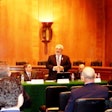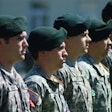One morning in May 1992, Ana Lizarraga hurriedly packed a few things into her van as she prepared to drive to the funeral of her mother. Lizarraga was a 49-year-old gang counselor for the Los Angeles Community Youth Services. She was an exceptional counselor, having relatives who were gang members in both Sureño and their rivals, the Norteño Gangs.
Lizarraga's gang knowledge had landed her a position as a technical advisor on the Edward James Olmos' film, "American Me." She had even played a small part in the film.
However unknown to most of Los Angeles, Olmos' movie had disrespected and offended the Mexican Mafia prison gang by depicting the fictional prison rape of one of its respected founders. This was cause enough for the other two technical advisors both of whom were Mafia members, "Rocky" Luna and "Charlie Brown" Manriquez, to be murdered. Later In covertly monitored Mexican Mafia meetings, I would learn that Olmos himself was marked for death.
On Lancaster Avenue, in the shadow of the Los Angeles General Hospital USCMC, Lizarraga stood on the driveway near the driver's door of her van. Her son was on the passenger side getting ready to open the door. They were startled to see two males walk quickly up her driveway and approached Ana. The men were dressed in dark clothing and their faces were covered with stocking masks.
Before Ana Lizarraga could react, she was cut down by multiple shots from both gunmen. The masked shooters stood over her and fired point blank, hitting her 13 times. Like the death scene in some gangster movie Lizarraga's body jerked and twisted in slow motion as the bullets ripped and tore through her and impacted on the driveway.
A lone LAPD Officer, Thomas Lira, happened to be passing by in his patrol car and witnessed the cold-blooded shooting. As the two masked suspects fled, one of them fired at the LAPD Officer. Units responding to Lira's request for assistance captured one of the shooters, Jose "Joker" Gonzales, a Big Hazard gang member. But the unidentified second shooter escaped.
"Joker" Gonzales was eventually convicted of the murder of Ana Lizzaraga, gang worker and grandmother, under California state laws.
And since the killing was ordered by the Mexican Mafia prison gang, his conviction later became one of the predicate acts used to convict 21 of 22 Mexican Mafia Members and associates in a 1995 federal criminal conspiracy trial. This was the first time the Racketeer Influenced and Corrupt Organization (RICO) statutes were used against a "violent gang" in California.
The federal RICO law was enacted in 1970 and codified as Chapter 96 of Title 18 of the U.S. Code. It was intended to combat traditional organized crime groups and Italian Mafia figures. Some suggest that the name RICO was a clever reference by the author of the law, G. Robert Blakey, to a character played by Edward G. Robinson in the classic gangster movie "Little Caesar."
The genius of the RICO statutes is that they work perfectly against organized criminal gangs. Any member of any criminal enterprise can be charged with RICO racketeering if he can be shown to have committed two of 27 federal or eight state charges within a 10-year period as part of the enterprise. A person can be charged even if that person did not directly commit the crime but only agreed to the commission or conspired with the perpetrators in any way.
Guilty verdicts result in sentences of 20 years per count and fines up to $25,000. In addition a pre-trial financial restraining order can be obtained to seize all the defendant's assets and forfeitable property. This prevents the organization from liquidating the proceeds of its racketeering enterprise before a guilty verdict can be obtained. Even the private individuals victimized by the enterprise can file civil suits to recover treble damages.
The very definition of a criminal gang begs prosecution under RICO. A gang is a group of three or more persons who have a common identifying sign, symbol or name, and whose members individually or collectively engage in a pattern of criminal activity for the furtherance of the gang.
Gang members know that RICO can ruin their lives. The Mexican Mafia in particular understood the implications of the RICO act. They purposely avoided a formalized structure, hierarchy, a written constitution, or codified code of conduct to avoid the fate their mentors, the Italian Mafia, suffered under RICO prosecutions.
State conspiracy laws and the federal RICO act are the tools tailor-made to combat criminal gangs. In my opinion the highly touted gang injunctions are difficult and costly to establish. They are extremely manpower intensive and usually duplicate gang-limiting conditions already available through good probation and parole conditions. Some of them are unnecessarily restrictive and could result in negative case law decisions.
When physical and electronic surveillance tactics, good informant development and the cooperation of narcotics units, parole and probation agencies are used to target violent criminal gangs, prosecution under state conspiracy and the federal RICO are the way to go.
But there are hurdles to jump.
First, I would solicit a memo of understanding with as many law enforcement entities as possible in the affected jurisdictions. This memo would form a multi-jurisdictional gang task force targeting the gang as a criminal enterprise and enumerate the level of cooperation each entity was willing to commit. How many investigators? How much of the budget? Who would prosecute?
This brings us to one of the RICO hurdles, getting the U.S. Attorney's Office to consider a RICO prosecution. There seems to be no clear guidelines as to when a U.S. Attorney should prosecute a case under federal laws.
Each local USA Office seems to have great autonomy in this consideration. In this case smaller cities may have the advantage since the Assistant U.S. Attorney in these offices might not be as busy as in large cities. In my experiece some Assistant U. S. Attorneys are looking for "sexy" cases to fill out their political résumés and might respond to some heavy lobbying by a police chief or local sheriff.
The recent highly publicised RICO case against the Aryan Brotherhood is an example of how these cases work. That case was developed by detectives "Barnie" Barnett and Roger Harryman from the Prison Gang Section of the Los Angeles Sheriff's Department. It was updated and advanced over the years by LASD Detectives Ed Godfrey, Mark Lillianfield and Mike McCravy, but the L.A. U.S. Attorneys Office took no interest in it until it was presented to them by federal agents from the BATF. So maybe you might need a federal agency to sponsor your task force in order to get the U.S. Attorney on board.
A RICO trial usually consists of two phases.
First you must prove the criminal organization or enterprise esists.
Secondly, you must prove that those charged in the indictment have each committed at least two acts of racketeering activity, one within the recent proscribed period and the second within 10 years. These are called "predicate acts" and they show a pattern of criminal acts as opposed to individual acts if they "have the same or similar purpose, results, participants, victims, or methods of commission, or otherwise are interrelated by distinguishing characteristics and are not isolated events."
The mere indictment of individuals under the RICO statutes usually results in many of the defendants pleding guilty to lesser charges. In the Mexican Mafia RICO of 1995, 22 defendants were originally indicted, all but 13 plead guilty. The trial resulted in 12 convictions and only one aquital.
The plot-driving device in the recent Batman movie, "The Dark Knight," is the Gotham District Attorney's use of the RICO act against the leaders of Gotham City's criminal elite. But it dosen't have to be a fantasy. You can do this in the real world against real-world gangsters. You can form a gang task force against your local criminal organizations and be a real hero.

















